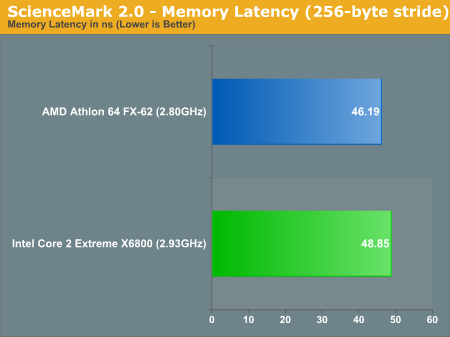Intel Core 2 Extreme X6800 Preview from Taiwan
by Anand Lal Shimpi & Gary Key on June 6, 2006 7:35 PM EST- Posted in
- CPUs
Memory Latency and Bandwidth
We've never been able to look at some of the low level characteristics of Intel's Core architecture, and although we didn't have enough time to do a thorough run of low level benchmarks we were able to run ScienceMark 2.0 in order to get an idea of how the Core 2 Extreme stacked up against the FX-62 in terms of memory latency and bandwidth.
We had seen Conroe performance results that showed the new architecture being able to offer fairly competitive memory access latencies to AMD's architecture, without the need of an on-die memory controller. Our ScienceMark 2.0 results confirm just that:
While AMD still offers lower memory latency, the Core 2 Extreme X6800 is very close in comparison - especially considering that it has no on-die memory controller. With lower clock speeds than its Pentium D siblings and a faster FSB, memory access latency is reduced tremendously with Conroe. On a larger scale, through a very effective cache subsystem as well as memory disambiguation, Conroe can offer significantly improved memory performance compared to its predecessors, including the Athlon 64 X2/FX.

ScienceMark's memory bandwidth results offer a very telling story, showing us the bandwidth limitations of Intel's FSB architecture. While the FX-62's peak theoretical bandwidth is not achieved in real world, you can see how AMD's Direct Connect architecture offers higher limits for chip-to-chip communication.











134 Comments
View All Comments
saratoga - Tuesday, June 6, 2006 - link
Seriously. Whats with all the noobs in here who can't read a benchmark?toyota - Tuesday, June 6, 2006 - link
whats the big deal? we just want to see what some realistic benchmarks look like in addition to the cpu specific ones.smitty3268 - Tuesday, June 6, 2006 - link
What you want is a gpu benchmark. What's the big deal? This is an article about cpus. If you want a gpu benchmark, go to another article because this one isn't for you.It's no different than if I were to come in and start complaining about how this article didn't test the performance of external usb hard drives. Sure, this article doesn't have anything to do with that, but I actually have a usb hdd and I don't have a Conroe, so it would be useful to me. Who cares about these stupid cpu tests, I want my usb hdd test!!!
IntelUser2000 - Tuesday, June 6, 2006 - link
But the result will be as expected, there will be no difference thanks for CPU limitations are high resolutions.
zsdersw - Tuesday, June 6, 2006 - link
If the clock speeds of Core 2 Duo at launch are all there is to ever be, maybe.. but that's probably about as likely as the US government paying off its debts and balancing the budget.
Miggle - Tuesday, June 6, 2006 - link
I can't believe that most loggers here just does not understand the concept of isolation in tests. We are testing CPU speed here and as much as possible, we want to keep the GPU from affecting the results. Sure the difference would be smaller once we apply AA/AF but thats not because the X2 starts running faster but because the GPU is beginning to limit the fps. 20% is a huge difference for CPUs in the same price range... AMD may have FX64 by the time core2 is released but its not going to chop down that 20% performance lead down to 15% even. I'm an AMD fan but I got to hand the crown to intel for Core2. I'm particularly looking at the $183 core2.... should be faster than the X2 3800+ and cooler tooclassy - Tuesday, June 6, 2006 - link
I don't think you understand. Years ago the cpu was the most important part of the system. That is far from the truth today. Truth is people play games with AA/AF and people do things at higher resolutions. That is just a fact of life. If you want to run pure cpu tests then run things at 640x480 then. That will show some facts, but escape the truth. Truth is the cpu is limited by the rest of the system components and who in the hell would pay $1000 for a cpu and put it in a system with to play games with no aa/af or run the desktop at 640x480. I think you fit in with that group of loggers you mentioned.coldpower27 - Wednesday, June 7, 2006 - link
Then let's GPU limit the FX 62 and Pentium EE 965 and bench them together and show there is no difference between them at high resolutions like 1920x1200. :D
This argument works in Intel's favour as well you know.
IntelUser2000 - Tuesday, June 6, 2006 - link
Except the gamers like my friend where he plays somewhat competitively and complains that he gets lag spikes playing DoD: Source with Pentium M 2.0GHz laptop(a Dell XPS M170) with Geforce 7800GTX Go, at 1024x768 resolution. He also runs at 1024x768 for BF2 because of the same reason, and he still notices lag.
There's another guy which notices lag with A64 3000+ Radeon 9800 running Counter-Strike based on the FIRST HL engine.
The ones who play competitively wouldn't notice. But the "normal" people will also notice no difference running the same system with Sempron or Celeron D.
IntelUser2000 - Tuesday, June 6, 2006 - link
The ones who doesn't play competitively wouldn't notice.